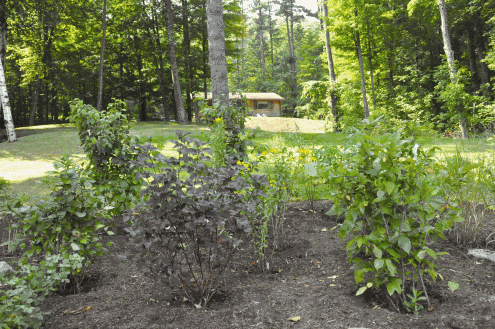
LGA Lake Steward Monika LaPlante holds samples of three invasive species Eurasian watermilfoil, curly-leaf pondweed and zebra mussels. These were pulled off a boat at Norowal Marina during her first day on the job for 2010.
The 2011 Lake Steward Program on Lake George will significantly expand over last year’s level, thanks to new funding provided by the Lake George Park Commission (LGPC).
Lake stewards, posted at several Lake George boat launches throughout the summer, inspect incoming boats for invasive species, remove suspicious specimens, and educate boaters about the threats of invasive species and how to prevent their spread. The Commission’s marine patrol is contacted whenever stewards encounter a boat being launched that has obvious signs of invasive species and is unwilling to be inspected.
Since 2008, the Lake George Association (LGA) has managed training, hiring, supervision and reporting for the Lake Steward Program.
The additional funding provided this year will provide maximum coverage for peak periods and for the launches that receive the highest traffic. The estimated program costs for 2011 are $67,000. $25,000 will be funded through the Lake Champlain Basin program, $35,000 will be provided by the Lake George Park Commission, and the LGA will provide the remaining funds from its Helen V. Froehlich Foundation grant awards.
In 2010, Lake stewards were posted at four launches around Lake George: Norowal Marina, Mossy Point, Hague Town Beach and Rogers Rock. In 2011, two additional launches will be added. Days and hours of coverage will also increase; the goal is to provide seven-day-a-week coverage during the busiest times of the season. Twelve-hour-a-day coverage is the goal for Mossy Point and Norowal, while other sites will receive eight hours per day. Mossy Point and Norowal were chosen for increased coverage due to the high volume of their traffic.
“The Lake George Lake Steward Program is critical to protecting the water quality of Lake George,” said Bruce Young, chair of the Lake George Park Commission. “By visually inspecting boats and trailers, and removing suspicious samples, the LGA stewards help stop the introduction and transport of invasive species between waterbodies throughout the Lake Champlain Basin and the Northeast,” he said.
“While dozens of different aquatic invasive species reside nearby, only four are currently found in Lake George. We aim to keep it that way,” said Emily DeBolt, LGA education director and manager of the Lake Steward Program on Lake George.
In addition to inspection, lake stewards will collect data about lake users and invasive species spread: the species found, number of boats launched, the type of boat, number of people in the boat, the last body of water the boat was in, and the presence of a LGPC decal. This information sheds light on the pathways of invasive species, and helps to identify target areas for early detection and control. A report for the public is prepared at the end of the season.
The program is closely coordinated with similar programs. Lake George, Lake Champlain, and the Adirondack Watershed Institute collaborate on training, printed materials, and data collection as members of a regional partnership, the Adirondack Park Invasive Plant Program (APIPP).
While Lake Stewards primarily cover boat launch sites, they also assist at special events such as the Adirondack Park Invasive Species Awareness Week, and inventory terrestrial invasive species on state-owned islands.
In 2010, Lake Stewards inspected a total of 2,538 boats, and educated boaters about the threats of Eurasian watermilfoil, zebra mussels, curly-leaf pondweed, and the Lake’s most recent invader, the Asian clam. Thirty-six samples of Eurasian watermilfoil were removed during the season. Nine samples of curly-leaf pondweed were found, three samples of zebra mussels, and five of water chestnut, an invasive that is not currently found in Lake George.
The 2010 Lake Steward Program was funded by the Bolton Local Development Corporation, the town of Hague, the town of Ticonderoga, the Lake George Park Commission, the Helen V. Froehlich Foundation, and the NYS Department of State with funds provided under Title 11 of the Environmental Protection Fund. The program was originally conceived by the Invasive Species Task Force of the Lake George Watershed Coalition.










